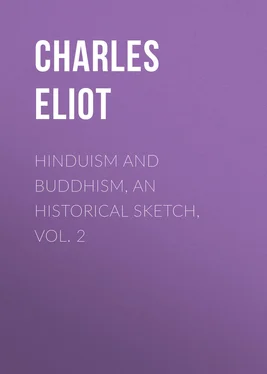Charles Eliot - Hinduism and Buddhism, An Historical Sketch, Vol. 2
Здесь есть возможность читать онлайн «Charles Eliot - Hinduism and Buddhism, An Historical Sketch, Vol. 2» — ознакомительный отрывок электронной книги совершенно бесплатно, а после прочтения отрывка купить полную версию. В некоторых случаях можно слушать аудио, скачать через торрент в формате fb2 и присутствует краткое содержание. Жанр: foreign_religion, Философия, Религиозная литература, foreign_psychology, foreign_antique, foreign_prose, на английском языке. Описание произведения, (предисловие) а так же отзывы посетителей доступны на портале библиотеки ЛибКат.
- Название:Hinduism and Buddhism, An Historical Sketch, Vol. 2
- Автор:
- Жанр:
- Год:неизвестен
- ISBN:нет данных
- Рейтинг книги:4 / 5. Голосов: 1
-
Избранное:Добавить в избранное
- Отзывы:
-
Ваша оценка:
- 80
- 1
- 2
- 3
- 4
- 5
Hinduism and Buddhism, An Historical Sketch, Vol. 2: краткое содержание, описание и аннотация
Предлагаем к чтению аннотацию, описание, краткое содержание или предисловие (зависит от того, что написал сам автор книги «Hinduism and Buddhism, An Historical Sketch, Vol. 2»). Если вы не нашли необходимую информацию о книге — напишите в комментариях, мы постараемся отыскать её.
Hinduism and Buddhism, An Historical Sketch, Vol. 2 — читать онлайн ознакомительный отрывок
Ниже представлен текст книги, разбитый по страницам. Система сохранения места последней прочитанной страницы, позволяет с удобством читать онлайн бесплатно книгу «Hinduism and Buddhism, An Historical Sketch, Vol. 2», без необходимости каждый раз заново искать на чём Вы остановились. Поставьте закладку, и сможете в любой момент перейти на страницу, на которой закончили чтение.
Интервал:
Закладка:
The word should perhaps be translated as body of the law and the thought originally underlying it may have been that the essential nature of a Buddha, that which makes him a Buddha, is the law which he preaches. As we might say, the teacher lives in his teaching: while it survives, he is active and not dead.
The change from metaphor to theology is illustrated by Hsüan Chuang when he states 94 94 Watters, vol. II. p. 38. "Spiritual essence" is Fa-shên in Chinese, i.e. Dharma-kâya. Another pass age is quoted to the effect that "henceforth the observances of all my disciples constitute the Tathâgata's Fa-shên, eternal and imperishable."
(no doubt quoting from his edition of the Pitakas) that Gotama when dying said to those around him "Say not that the Tathâgata is undergoing final extinction: his spiritual presence abides for ever unchangeable." This apparently corresponds to the passage in the Pali Canon, 95 95 Mahâparinib. Sut. VI. i.
which runs "It may be that in some of you the thought may arise, the word of the Master is ended: we have no more a teacher. But it is not thus that you should regard it. The truths and the rules which I have set forth, let them, after I am gone, be the Teacher to you." But in Buddhist writings, including the oldest Pali texts, Dharma or Dhamma has another important meaning. It signifies phenomenon or mental state (the two being identical for an idealistic philosophy) and comprises both the external and the internal world. Now the Dharma-kâya is emphatically not a phenomenon but it may be regarded as the substratum or totality of phenomena or as that which gives phenomena whatever reality they possess and the double use of the word dharma rendered such divagations of meaning easier. 96 96 Something similar might happen in English if think and thing were pronounced in the same way and a thing were believed to be that which we can think.
Hindus have a tendency to identify being and knowledge. According to the Vedânta philosophy he who knows Brahman, knows that he himself is Brahman and therefore he actually is Brahman. In the same way the true body of the Buddha is prajñâ or knowledge. 97 97 See Ashtasâhasrikâ Prajñâ-pâramitâ, chap. IV, near beginning.
By this is meant a knowledge which transcends the distinction between subject and object and which sees that neither animate beings nor inanimate things have individuality or separate existence. Thus the Dharma-kâya being an intelligence which sees the illusory quality of the world and also how the illusion originates 98 98 It is in this last point that no inferior intelligence can follow the thought of a Buddha.
may be regarded as the origin and ground of all phenomena. As such it is also called Tathâgatagarbha and Dharma-dhâtu, the matrix or store-house of all phenomena. On the other hand, inasmuch as it is beyond them and implies their unreality, it may also be regarded as the annihilation of all phenomena, in other words as Nirvana. In fact the Dharma-kâya (or Bhûta-tathatâ) is sometimes 99 99 The Awakening of Faith , Teitaro Suzuki, p. 59.
defined in words similar to those which the Pali Canon makes the Buddha use when asked if the Perfect Saint exists after death—"it is neither that which is existence nor that which is non-existence, nor that which is at once existence and non-existence nor that which is neither existence nor non-existence." In more theological language it may be said that according to the general opinion of the Mahayanists a Buddha attains to Nirvana by the very act of becoming a Buddha and is therefore beyond everything which we call existence. Yet the compassion which he feels for mankind and the good Karma which he has accumulated cause a human image of him (Nirmâna-kâya) to appear among men for their instruction and a superhuman image, perceptible yet not material, to appear in Paradise.
CHAPTER XIX
MAHAYANIST METAPHYSICS
Thus the theory of the three bodies, especially of the Dharma-kâya, is bound up with a theory of ontology. Metaphysics became a passion among the travellers of the Great Vehicle as psychology had been in earlier times. They may indeed be reproached with being bad Buddhists since they insisted on speculating on those questions which Gotama had declared to be unprofitable and incapable of an answer in human language. He refused to pronounce on the whence, the whither and the nature of things, but bade his disciples walk in the eightfold path and analyse the human mind, because such analysis conduces to spiritual progress. India was the last country in the world where such restrictions were likely to be observed. Much Mahayanist literature is not religious at all but simply metaphysics treated in an authoritative and ecclesiastical manner. The nature and origin of the world are discussed as freely as in the Vedânta and with similar results: the old ethics and psychology receive scant attention. Yet the difference is less than might be supposed. Anyone who reads these treatises and notices the number of apparently eternal beings and the talk about the universal mind is likely to think the old doctrine that nothing has an âtman or soul, has been forgotten. But this impression is not correct; the doctrine of Nairâtmyam is asserted so uncompromisingly that from one point of view it may be said that even Buddhas do not exist. The meaning of this doctrine is that no being or object contains an unchangeable permanent self, which lives unaltered in the same or in different bodies. On the contrary individual existences consist of nothing but a collection of skandhas or a santâna , a succession or series of mental phenomena. In the Pali books this doctrine is applied chiefly to the soul and psychological enquiries. The Mahayana applied it to the external world and proved by ingenious arguments that nothing at all exists. Similarly the doctrine of Karma is maintained, though it is seriously modified by the admission that merit can be transferred from one personality to another. The Mahayana continued to teach that an act once performed affects a particular series of mental states until its effect is exhausted, or in popular language that an individual enjoys or suffers through a series of births the consequences of previous acts. Even the instance of Amitâbha's paradise, though it strains the doctrine of Karma to the utmost, does not repudiate it. For the believer performs an act—to wit, the invocation of Amitâbha—to which has been attached the wonderful result that the performer is reborn in a blessed state. This is not essentially different from the idea found in the Pali Canon that attentions paid to a Buddha may be rewarded by a happy rebirth in heaven. 100 100 E.g. in Mahâparinib. Sut. IV. 57, the Buddha says "There has been laid up by Cunda the smith (who had given him his last meal) a karma, redounding to length of life, to good fortune, to good fame, to the inheritance of heaven , and of sovereign power."
Mahayanist metaphysics, like all other departments of this theology, are beset by the difficulty that the authorities who treat of them are not always in accord and do not pretend to be in accord. The idea that variety is permissible in belief and conduct is deeply rooted in later Buddhism: there are many vehicles, some better than others no doubt and some very ramshackle, but all are capable of conveying their passengers to salvation. Nominally the Mahayana was divided into only two schools of philosophy: practically every important treatise propounds a system with features of its own. The two schools are the Yogâcâras and Mâdhyamikas. 101 101 Strictly speaking Madhyamaka is the name of the school Mâdhyamika of its adherents. Both forms are used, e.g. Madhyamakakârikâs and Mâdhyamikasûtra.
Both are idealists and deny the reality of the external world, but whereas the Yogâcâras (also called Vijñânavâdins) admit that Vijñâna or consciousness and the series of states of which it consists are real, the Mâdhyamikas refuse the title of reality to both the subjective and the objective world and hence gained a reputation of being complete nihilists. Probably the Mâdhyamikas are the older school.
Интервал:
Закладка:
Похожие книги на «Hinduism and Buddhism, An Historical Sketch, Vol. 2»
Представляем Вашему вниманию похожие книги на «Hinduism and Buddhism, An Historical Sketch, Vol. 2» списком для выбора. Мы отобрали схожую по названию и смыслу литературу в надежде предоставить читателям больше вариантов отыскать новые, интересные, ещё непрочитанные произведения.
Обсуждение, отзывы о книге «Hinduism and Buddhism, An Historical Sketch, Vol. 2» и просто собственные мнения читателей. Оставьте ваши комментарии, напишите, что Вы думаете о произведении, его смысле или главных героях. Укажите что конкретно понравилось, а что нет, и почему Вы так считаете.












